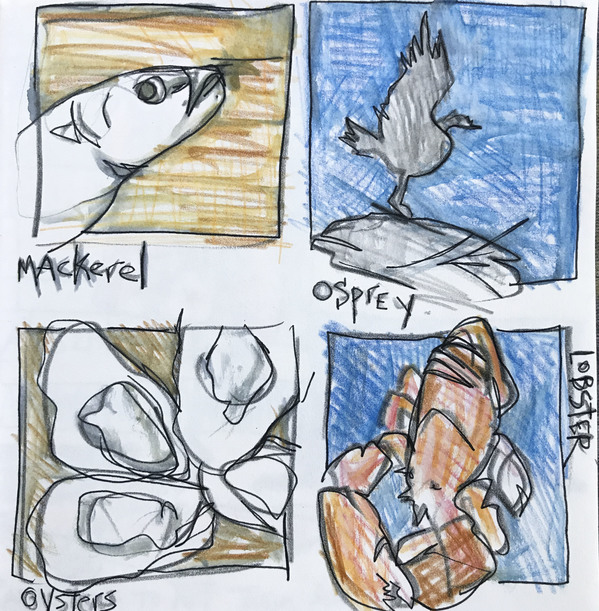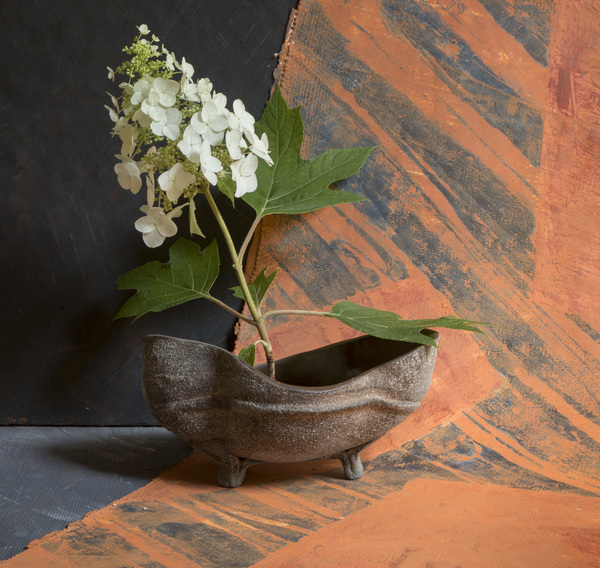In the summertime I keep a journal that is based on stringing beads. I draw a loose line down the side of my page and then make five or six circles on the line like beads on a thread. I write down an observation, an experience, or a line overheard and make small drawings based on the day. I just try to keep it simple and specific. I work from what's in front of me, not what I think I see but what I am really seeing. The drawing and lists create their own reality.
Making a drawing is like touching the experience. It becomes a documentation of time. I trust the intelligence of the hand over the thought. The lists transitions from home-body daily habits into vacationland patterns--new sequences into the colors of island, ocean fog and water reflections. The beads might reflect that on arrival the boat was there but the motor was kaput. Or while the house is proudly standing, the refrigerator is warm.
I document the moonrise and collect sea rounded bricks. The focus on trees and the spaces beyond the limbs are fodder for images. So the water through the trees goes on the inventory. I may record the kind of fish we saw pulled off a boat at the lobsterman's co-op, where we swam at what tide or the handfuls of flowers we collected on our morning wander.
Brush marks are put down, accepted like a child's random pattern of beads on a string. The pages of color and patterns capturing sequential walks on the rocks amass themselves into a necklace. Perceptually slowed down, I notice snail trails on the rocks at my high tide swimming refuge, the subtle colors of sunrise through the bedside window. The list goes on--dock, water, cup, rock, swim, stump, shingle, repeat and repeat.
Edward Hopper said if he could say it in words there would be no reason to paint. If I knew what I was going to get out of my trip each year I wouldn't have to go. If I knew where the pages might take me, why fill them. The vistas are so scenic that painting the view feels like a cliché. So instead I turn to crushing shells, sumac leaves and sand. Weeds and mud became my muse.
Making a drawing is like touching the experience. It becomes a documentation of time. I trust the intelligence of the hand over the thought. The lists transitions from home-body daily habits into vacationland patterns--new sequences into the colors of island, ocean fog and water reflections. The beads might reflect that on arrival the boat was there but the motor was kaput. Or while the house is proudly standing, the refrigerator is warm.
I document the moonrise and collect sea rounded bricks. The focus on trees and the spaces beyond the limbs are fodder for images. So the water through the trees goes on the inventory. I may record the kind of fish we saw pulled off a boat at the lobsterman's co-op, where we swam at what tide or the handfuls of flowers we collected on our morning wander.
Edward Hopper said if he could say it in words there would be no reason to paint. If I knew what I was going to get out of my trip each year I wouldn't have to go. If I knew where the pages might take me, why fill them. The vistas are so scenic that painting the view feels like a cliché. So instead I turn to crushing shells, sumac leaves and sand. Weeds and mud became my muse.
It's as if the upper right hand corner of any given page might hold the light and direction for my mind. Through the inscriptions on the page I find the trees and discover direction inside the blue sky of the afternoon. The page itself creates a moment of quiet after the bustle of the day and before we have a thought about dinner. The moment of pause, the ability to translate seaweed into calligraphy--these are the indecipherable flashes, the inspirational moments. I thread the shift of light into the next shift of the wind's direction. These beads touch my mind, straighten my spine and connect the space between the boats. The gap between breathes, the distance between home and island all disappear.
"Life is a train of moods like a string of beads and as we pass through them they prove to be many-colored lenses which paint the world their own hue, and each shows only what lies in it's focus," wrote Emerson. To find oneself trapped in any one bead, no matter what its hue, can be deadly.
--Maggie Nelson, Bluets
--Maggie Nelson, Bluets


Leave a comment